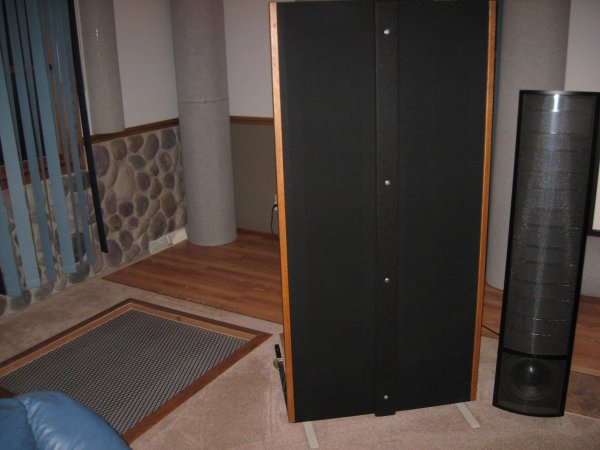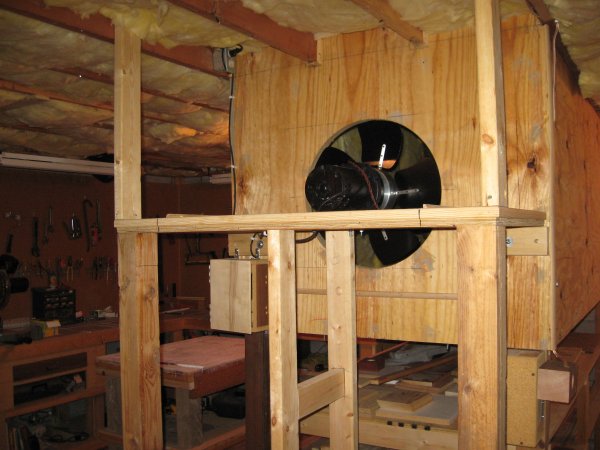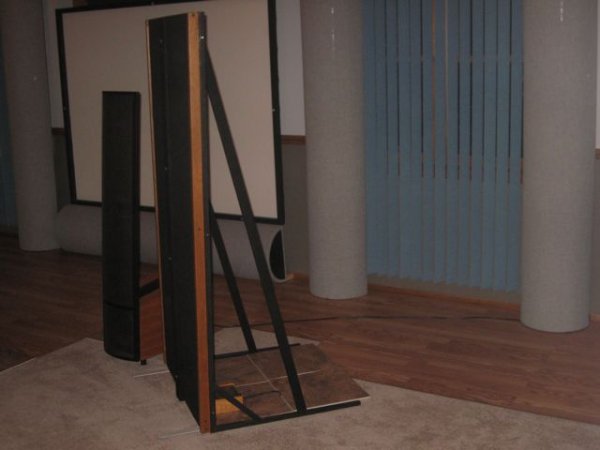The Neolith, with the largest panel ML has made to date -- really? 22" x 48"? I have a pretty good eye, so decided to measure my CLS panel. OK, so it's an inch shy in both directions: 21" x 47". I'd say that's negligible.
Now about those woofer sections. What I've discovered over 25 years of living with my ML electrostats, and listening to all kinds of other designs/offerings, is that no one (including ML, and Sanders) has
ever been able to make a "hybrid" electrostat (that is, an ES panel + an EM woofer per side) that will create the same sound field as a truly "full range" electrostat would,
if possible. It simply has to be full-range-
all-electrostat, or nothing (more on why in a minute.) The best (or
closest) examples we have, of full-range electrostatic panels, are the big Soundlabs, the nearly-as-full-range CLS, and the barely qualifying CLX. In fact, the Soundlabs are the only ones that can be considered
truly full-range; although at the lowest frequency registers, their output has a hard time "keeping up", so to speak.
If you have a pair of electrostatic panels that go down respectably low (Soundlab - 24Hz, CLS - 32Hz, CLX -52Hz) and that produce a credible sonic hologram (sound field) on their own, then the job is
NOT to add/match bass to each panel in the form of a non-electostatic driver! The out-of-control phasing alone just screws up the whole sound field! And if the panels themselves don't go low enough, as was begun with the Statements for example, the problems are further compounded, because the EM low frequency drivers now have to produce sound
above 100Hz, which suddenly makes them easy to locate, and therefore to separate out from the panels! This approach is a disaster. It always was and always will be. Which is
why those with the money and the space finally wind up with Soundlabs, if the wife allows.
The best solution, for adding more bass to the limited low frequency output of (even the
most full range) electrostatic panels, is to somehow match a "
bass sound field" (below say 30Hz - 40HZ) to the
electostatic sound field produced by the panels above that frequency.
So. What are the characteristics of a stereo sound field produced by a pair of electrostatic panels? Well first, as we all know, the front-propagating wave is 180 degrees out-of-phase with the rear-propagating wave. Second, there is an approximately 20 degree "null" area extending from the left and right edges of each panel -- due to frequency cancellation between the front and rear waves. And third, and most important to keep in mind, the frequency response of even the most full range electrostatic panels falls off significantly below 80Hz - which just so happens to be
the very point at which sound becomes
non-directional to human perception! This is important to remember because if you can limit your need for bass augmentation to below 100Hz, and preferably below 40Hz (which is entirely possible with the full-range panels I mentioned,) then
you don't need two sources of bass in order to preserve the soundstage!
I'm hoping there are no strong objections so far?

OK. So what would be the characteristics of a "bass sound field" that could be easily superimposed on the holographic sound field already created by the panels? Well first of all, it would only need to have a single source, since there would be no need to create a "stereo image" at frequencies below that magic 100Hz. Second, the bass transducer/driver would need to be in the same plane as the one formed by the two panels, in order that the bass wave be "launched" from the same point (time-aligned) as the wave(s) produced by the panels. And third, the front-facing half of the low frequency wave would need to be 180 degrees out-of-phase with the rear-facing half.
The simplest, most obvious (and oldest!) solution would be to mount a woofer in an infinite baffle, and position it right between and in line with the panels, and it's done! Well not quite, unfortunately. First of all, placing a large enough (infinite?) baffle in that location would all but destroy the soundstage created by the panels. And expecting a woofer mounted in an infinite baffle to have transient response (fast enough) to match that of the panels is out of the question. So alas, an enclosure of some kind is needed.
The most respected dipole subwoofer design (front and rear drivers in a single enclosure, connected out of phase) is this one:
http://www.linkwitzlab.com/woofer.htm but I think you have to build it yourself (none available commercially, I don't think); and custom tailor it's characteristics to your panels, amplifier, etc. A simpler (OK, more expedient!) solution would be to purchase a subwoofer with an omnidirectional radiating pattern, and set its phase response to 90 degrees (splitting the difference between 0 deg. and 180 deg.). The candidates would be one of the better down-firing subs (with good transient response, of course!) or one of the "Balanced Force" ML subs: the old Depth/Descent, or their current offering 210 and 212. I'm partial to the Depth/Descent, but only because the newer units use DSP (digital signal processing) and I prefer to keep all digitizing, when necessary, on
the other side of my preamp, if you know what I mean!
This arrangement has provided me with electrostatic bliss for many years:
1. Full range electrostatic panels, with the low frequency response allowed to decay naturally (no low-pass cut off.)
2. A single, omnidirectional subwoofer, centered
exactly between the panels left/right and front/back; with phase response set to 90 degrees, and high-pass set near or just below the lowest frequency response of the panels (usually somewhere between 30Hz and 50Hz)
3. Set level to taste, but keep it lower than you think it should be

And as for the "amazing" new (now TOTALLY PASSIVE, mind you!) ML Neolith? I ain't buying it! Literally
and figuratively!
 My answer to the Neolith hybrid is combining Magneplanar Tympani IV bass panels
My answer to the Neolith hybrid is combining Magneplanar Tympani IV bass panels My answer to the Neolith hybrid is combining Magneplanar Tympani IV bass panels
My answer to the Neolith hybrid is combining Magneplanar Tympani IV bass panels


